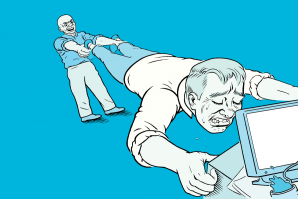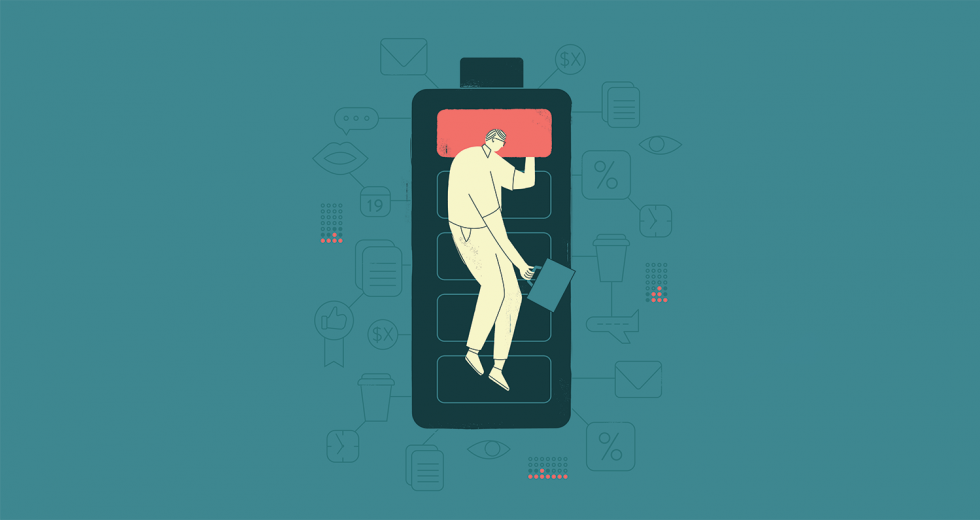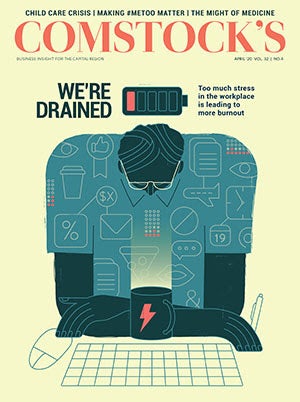Editor’s note: This story was reported and written for Comstock’s April print edition, before California’s lockdown due to the coronavirus.
Josh Hanosh worked at a middle school in Rocklin, teaching math and computer science. He loved the kids. He knew the work was important. The pay? Not spectacular, but he considered it to be “decent money,” at least when factoring in the vacation time. At parties, people would tell him, “You have such a noble job, you must feel great!”
Yet he had a secret: He didn’t feel great at all, he had no energy, and, as he says now, “I was not excited about life, to be honest.” He felt burned out.
While teaching is considered a career with a high burnout rate — a 2018 survey by the American Federation of Teachers says 61 percent of teachers indicated their jobs were always or often stressful — any job or career, no matter how fulfilling, can lead to burnout. Take physicians. Dr. Peter Yellowlees, chief wellness officer of UC Davis Health, has extensively researched burnout in medical doctors, and says it leads to depression, which helps explain why 400 physicians commit suicide in the U.S. every year. “The financial bottom line should not be the only bottom line,” says Yellowlees. “Burnout, particularly for physicians, is a significant moral issue.”
The World Health Organization defines burnout as “chronic workplace stress that has not been successfully managed” and characterized by three dimensions: feelings of exhaustion, a cynical and negative attitude, and “reduced professional efficacy.” Even if we ignore morality, burnout can hurt the financial bottom line. Too much stress costs employers $300 billion a year, according to The American Institute of Stress, as burnout spikes the risk of employee turnover, lack of motivation and dips in productivity. A 2018 Gallup study found that burned-out employees are 63 percent more likely to take a sick day and 2.6 times as likely to look for another job.
“Burnout is a red flag for an organization,” says Christina Maslach, a professor of psychology at UC Berkeley and one of the pioneering researchers on occupational burnout who has been studying it since the 1970s. She likens burnout to a canary in a coal mine — when the bird dies, it’s a signal of poisonous gases. “When the canary goes down, you don’t focus on how to make the canary more resilient. You fix the coal mine.”
The Cause
The subject of burnout can be taboo. When Maslach first published stories about burnout in 1976, she was flooded with letters from readers that said things like, “I thought I was the only one!” It’s a stigma. “People are afraid their bosses will say, ‘You aren’t cut out for this. If you can’t take the heat, get out of the kitchen,’” says Maslach. Yet it’s widespread, with about two-thirds of full-time workers experiencing it; that Gallup study found 23 percent of employees are burned out very often or always, and another 44 percent sometimes.
“Because the problem is being expressed by individual people, there’s a tendency to think that they’re sick, or they’re ill. But the research says what’s much more important is the environment they’re working in.”
CHRISTINA MASLACH PROFESSOR OF PSYCHOLOGY, UC BERKELEY
The cause of burnout for Hanosh, the teacher, wasn’t just about the workload. He was frustrated by the bureaucracy: When $50,000 had been approved to buy the classrooms at his school 3-D printers and Raspberry Pi computers, he says he still had to “pull teeth” to make any purchases. He was also bothered by what he perceives to be a lack of fairness. Hanosh says he worked extra hours without any bump in pay, yet the more tenured teachers were “getting paid double than what I was, and they arrived right before the first bell, and left right after the ending bell.”
In other words, the root cause of Hanosh’s burnout was what he felt to be inequities in the system (whether real or perceived), not some personal failing. And that’s usually the case. “Because the problem is being expressed by individual people, there’s a tendency to think that they’re sick, or they’re ill,” says Maslach. “But the research says what’s much more important is the environment they’re working in.”
Maslach’s research identifies six common organizational causes of burnout. She says the first one is obvious, but the other five can matter just as much, and often more.
- Too high of a workload with too few resources, leading to exhaustion.
- Not enough control and autonomy.
- Lack of rewards and positive feedback. Maslach clarifies that “people often think of this as the tangible things, like salary and benefits, but the data shows that what’s more important is social recognition — someone pays attention to you, and realizes that you did something good.”
- Not a strong sense of community or support.
- A lack of fairness. Maybe it’s about compensation (like with Hanosh), or maybe it’s a sense that you are cheated of the plum assignments or the corner office.
- Misaligned values, such as a pacifist who works for a weapons manufacturer. “The more the values are out of whack between the person and the environment, the more the risk of burnout,” says Maslach.
That third item on the list, a lack of positive feedback, is something Renata Peterson, a Sacramento-based life coach, frequently sees in her clients. “It’s not that employees need a pat on the back every single day, but they need something to show that they are appreciated,” she says.
Peterson suggests an additional cause of burnout, one that is less about the shortcomings of the organization and more about a mismatch between the person and the job; she sees burnout among clients who are “not really living their true selves,” in the sense that their role, or even career, is misaligned with their true interests or passions. “Maybe the child wanted to be an artist, but the parent pushed them to go into college for something else,” Peterson says.
The Cure
When we try to address burnout, our first instincts are often wrong. Dr. Daniel Rockers, a Sacramento psychologist, says the default way most people cope with burnout is “by blocking it, by numbing themselves.” That could be through alcohol, getting a massage or even taking a vacation. “That’s just another distraction,” says Rockers. “That’s about as effective as sending a get-well card to somebody with depression. It’s not a long-term fix.”
The longer-term fix starts with talking to others, seeking outside perspective and thinking deeply about what you really want to do and whether that’s possible in your current role. While it’s crucial to confide in others, Rockers advises against surrounding yourself with other disgruntled coworkers who share the same negativity, otherwise you might “get stuck in a cell of complainers,” creating a toxic echo chamber.
Here’s where it gets tricky. How do you know if your burnout stems from an organization-caused deficiency (like lack of fairness, one of Maslach’s six drivers) or an existential mismatch between your passion and your work? “Try to figure out if you can align what you want to do and what you’re doing,” says Rockers. “Maybe in your current role and maybe in a new job or career.”
Rockers says the first step is to ask what do you like doing, what gives you pleasure. Paradoxically, burned-out people are often so glum they respond, “I don’t like doing anything. I’m too tired,” so he’ll then ask, “When you were younger, what were some of the things you were interested in?”
Hanosh asked himself those kinds of questions. He taught himself how to code while teaching computer science classes and realized he loved it, so in 2018, he left teaching to start his own web design and marketing company, Dedicated Designs. “I probably work the same amount of hours now as I did before, if not more, but I love it,” says Hanosh.
Or take Payam Fardanesh. As a traveling salesman for Intuit, he once logged 200,000 miles in 18 months. “And I wasn’t going to Shanghai or Bali,” he says, “but just going to the East Coast every three weeks. Red eyes. From Florida to Georgia to Vermont to New York, over and over. That’s not a life.” In this zombie mode, he was at “peak burnout.” From the depths of this exhaustion, Fardanesh realized what he really cared about was entrepreneurship, and after first launching a project management software company, he remembered a drink from his childhood in Iran, a sort of summer lemonade called sekanjabin — made with vinegar, mint, sugar and water — and he turned this concept into his organic beverage company, Silk Road Soda, based in Roseville.
These success stories are examples of hope, but while it’s possible for burned-out employees to take those lemons and make lemonade, the onus shouldn’t be on workers to find new careers. Since burnout usually stems from environmental factors, organizations should work on fixing the root problems.
“It’s much better to prevent the conditions that create burnout than to treat burnout once it has happened.”
KIMBERLY ELSBACH PROFESSOR OF MANAGEMENT, UC DAVIS
Just as it’s better to prevent a fire from starting than it is to extinguish the flames, ideally, the first step should be prevention. “It’s much better to prevent the conditions that create burnout than to treat burnout once it has happened,” says Kimberly Elsbach, a professor at UC Davis Graduate School of Management. And the best way to prevent burnout, she says, is boosting employee engagement, which clearly addresses the no-control-or-autonomy cause of burnout. There’s no one silver bullet, but Elsbach says the first step for leadership is to just “ask the questions to the group and involve them in the solution.” Then the organization collaborates as a whole.
Maslach agrees, citing the “top down” approach as a big mistake. Too often, Maslach says, executives slap a bandage on the problem with something like, say, putting volleyball courts on the roof. “But does anyone really want that?” she asks. “You need to get input from the people who have been struggling.”
There’s some good news for organizations. Because “too much workload” is not necessarily the cause of burnout, it’s possible to boost employee engagement without reducing output. Improving conditions like “fairness” doesn’t reduce the output of widgets or eat into the profit, but managers should do these five things, according to the 2018 Gallup analysis: Listen to work-related problems, foster an environment of teamwork, solicit employees’ opinions, make the work purposeful and give people work that aligns with their strengths.
Returning to the canary in the coal mine metaphor, Maslach says the real takeaway of burnout is that a company needs to hunt for the “poisonous gases” that killed the canary. What’s not working properly? What’s the red tape that’s gumming up the operation? What are the inefficiencies that drive everyone bonkers?
That’s why, to reduce burnout in physicians, Yellowlees is pushing for specific changes to medical practices that can trim inefficiencies, such as allowing more remote working (using video conferencing), cutting paperwork and improving the computer interfaces used by physicians. “They’ve been designed by engineers,” says Yellowlees, and the engineers don’t realize that the doctor might have to press the same button seven times in each session with a patient, and over hundreds of sessions, those clicks add up and gobble the hours.
The point is that the underlying workflow matters, the processes matter, and the organization matters. Burnout is rarely just a personal problem.
—
Stay up to date on business in the Capital Region: Subscribe to the Comstock’s newsletter today.
Recommended For You

The Neurological Reasons You’re Up Against Deadlines, and How to Make a Change
Do you find yourself unable to get ahead of your deadlines? Can’t shake the feeling that you do your best work under pressure? Turns out, you might be addicted to procrastination-induced adrenaline.

Feel the Burn
Women are buckling in a professional war of attrition
Senior associate Tracy Steffens starts getting urgent emails from East Coast clients as early as 6 a.m., just around the time her two-year-old daughter raps on the shower door to expel mommy from her morning rinse.

Meeting Goals
Sure, we all hate meetings — but they are essential, and there are ways to make them better
I bet you a cup of coffee that you are reading this just before a meeting, or maybe just after. Another bet: You feel that there are too many meetings. A third: This gauntlet of meetings can make it tough — or impossible — to finish your work.

Take It Easy
U.S. workers are taking less and less vacation — here’s what their employers are losing to the vacation gap
You probably need a vacation. Most of America does. Between 1976 and 2000, the average worker took roughly 20 vacation days annually, according to data from Project: Time Off. But as the economy buckled in 2008, so did our desire to flock to the beach, and in 2015, the number plunged nearly a full week lower, translating to 658 million unused vacation days.




